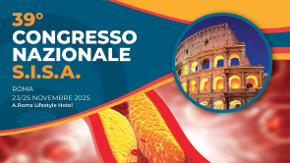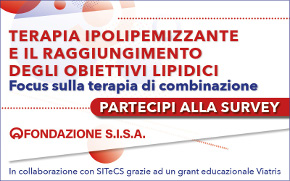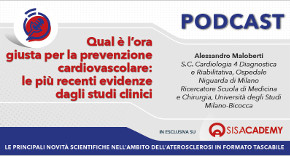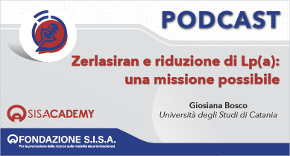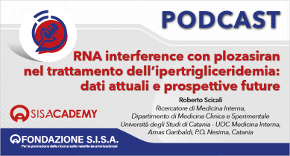 Rivista in lingua italiana
Rivista in lingua italiana
riservata ai Soci SISA
Ultimo numero:
Anno 16 • N.1/2025
SISANews
Confronto tra due obiettivi di colesterolo LDL dopo ictus ischemico
In questo studio a gruppi paralleli condotto in Francia e Corea del Sud, sono stati arruolati 2.860 pazienti (età media di 67 anni; 68% maschi), di cui l’86% con ictus ischemico entro i 3 mesi precedenti e il 14% con un attacco ischemico transitorio (TIA) nei 15 giorni precedenti. I soggetti sono stati randomizzati 1:1 a un obiettivo per il colesterolo LDL più basso (<70 mg/dL) o più alto (90-110 mg/dL); i medici locali potevano prescrivere loro qualsiasi statina in associazione o meno con ezetimibe. Il principale risultato emerso è che dopo ictus ischemico o TIA con evidenze di aterosclerosi, i soggetti che venivano indirizzati a livelli di colesterolo LDL inferiore a 70 mg/dL avevano un rischio inferiore di sviluppare eventi cardiovascolari successivi rispetto ai pazienti con colesterolo LDL nel range tra 90-110 mg/dL.
![]()
A Comparison of Two LDL Cholesterol Targets after Ischemic Stroke
Amarenco P, Kim JS, Labreuche J, Charles H, Abtan J, Béjot Y, Cabrejo L, Cha JK, Ducrocq G, Giroud M, Guidoux C, Hobeanu C, Kim YJ, Lapergue B, Lavallée PC, Lee BC, Lee KB, Leys D, Mahagne MH, Meseguer E, Nighoghossian N, Pico F, Samson Y, Sibon I, Steg PG, Sung SM, Touboul PJ, Touzé E, Varenne O, Vicaut E', Yelles N, Bruckert E; Treat Stroke to Target Investigators.
N Engl J Med. 2020;382:9-19
BACKGROUND The use of intensive lipid-lowering therapy by means of statin medications is recommended after transient ischemic attack (TIA) and ischemic stroke of atherosclerotic origin. The target level for low-density lipoprotein (LDL) cholesterol to reduce cardiovascular events after stroke has not been well studied.
METHODS In this parallel-group trial conducted in France and South Korea, we randomly assigned patients with ischemic stroke in the previous 3 months or a TIA within the previous 15 days to a target LDL cholesterol level of less than 70 mg per deciliter (1.8 mmol per liter) (lower-target group) or to a target range of 90 mg to 110 mg per deciliter (2.3 to 2.8 mmol per liter) (higher-target group). All the patients had evidence of cerebrovascular or coronary-artery atherosclerosis and received a statin, ezetimibe, or both. The composite primary end point of major cardiovascular events included ischemic stroke, myocardial infarction, new symptoms leading to urgent coronary or carotid revascularization, or death from cardiovascular causes.
RESULTS A total of 2860 patients were enrolled and followed for a median of 3.5 years; 1430 were assigned to each LDL cholesterol target group. The mean LDL cholesterol level at baseline was 135 mg per deciliter (3.5 mmol per liter), and the mean achieved LDL cholesterol level was 65 mg per deciliter (1.7 mmol per liter) in the lower-target group and 96 mg per deciliter (2.5 mmol per liter) in the higher-target group. The trial was stopped for administrative reasons after 277 of an anticipated 385 end-point events had occurred. The composite primary end point occurred in 121 patients (8.5%) in the lower-target group and in 156 (10.9%) in the higher-target group (adjusted hazard ratio, 0.78; 95% confidence interval, 0.61 to 0.98; P=0.04). The incidence of intracranial hemorrhage and newly diagnosed diabetes did not differ significantly between the two groups.
CONCLUSIONS After an ischemic stroke or TIA with evidence of atherosclerosis, patients who had a target LDL cholesterol level of less than 70 mg per deciliter had a lower risk of subsequent cardiovascular events than those who had a target range of 90 mg to 110 mg per deciliter. (Funded by the French Ministry of Health and others; Treat Stroke to Target ClinicalTrials.gov number, NCT01252875.).

Area Soci
Eventi
39° Congresso Nazionale
 39° Congresso Nazionale
39° Congresso NazionaleRoma, 23-25 novembre 2025
Save the date




 Spring Meeting Gruppi Giovani SID, SIGG, SIIA, SIMI, SIPREC, SISA
Spring Meeting Gruppi Giovani SID, SIGG, SIIA, SIMI, SIPREC, SISARimini, 6-8 aprile 2025
[continua a leggere]
 SISA LIPID ACADEMY - Corso avanzato di lipidologia clinica
SISA LIPID ACADEMY - Corso avanzato di lipidologia clinicaModena, 4-5 Luglio 2024
[continua a leggere]Giornale Italiano Arteriosclerosi
HoFH today
 Rivista Italiana della
Rivista Italiana della
Ipercolesterolemia
Familiare Omozigote
Anno 6 • N.1/2024
Rivista NMCD
Diateca
[continua a leggere]
[continua a leggere]
Newsletter
il vostro indirizzo di posta elettronica
Progetto LIPIGEN

Nuovo sito dedicato al Progetto LIPIGEN
Progetto LIPIGEN - Vecchio portale
E' necessario essere loggati come utente
Lipigen per poter accedere alla pagina
PROject Statin Intolerance SISA
PROSISA – PROject Statin Intolerance SISA
E' necessario essere loggati come utente
PROSISA per poter accedere alla pagina
GILA - Lipoprotein Aferesi
Gruppo Interdisciplinare Lipoprotein Aferesi
(Accesso Gruppo GILA-Lipoprotein Aferesi)
E' necessario essere loggati come utente del Gruppo GILA per poter accedere
Gruppo Interdisciplinare Lipoprotein Aferesi
(Documentazione ad accesso libero)
Pagina informativa per medici e pazienti


